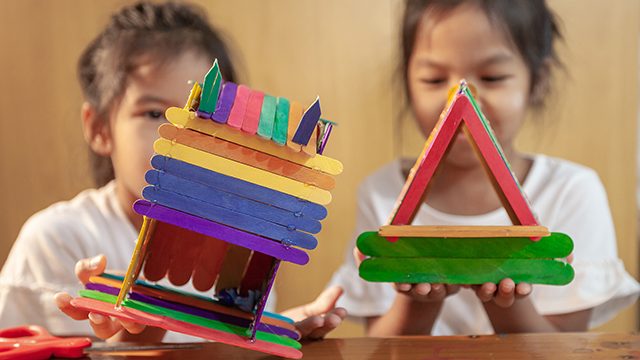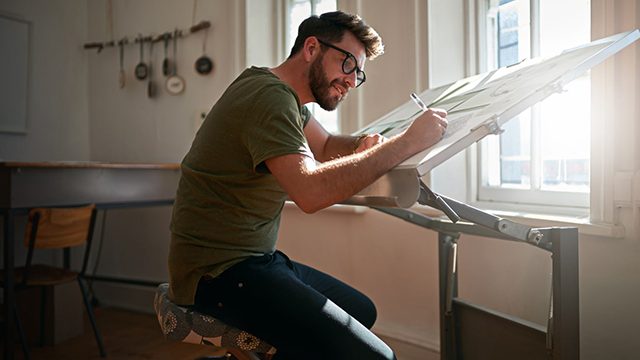“Painting is one of my ways of clearing my ever busy mind. My passion right now is sharing my God-given talent with others. When someone truly is happy with a finished piece it makes my heart smile.” Storyboard artist Sydney is the practice of producing sketches for a script/concept.
Texas Hill Country artist Stephanie Ayers is a wife, mother of two and a self-taught painter. Painting, cooking, fishing, and gardening come naturally to her and she enjoys sharing art, food and flowers with others. Stephanie laughs, “I’d share the fish too but typically I only catch one inch perch.”
The very small town where she was an elementary student was one building, Pre-K through 12th grade, “… being one of two semi-talented kids in the entire town I thought I was the ONLY girl my age IN THE WORLD that knew how to make art. My first memory of painting is when I first entered school. Then it seemed so complicated and difficult to control. I remember thinking crayons and chalk are so much easier.”
With that in mind, upon moving to Waco to finish college she found herself in, as she puts it “this HUGE new school… I was like, ‘Um no… Wait… there are other people my age that can color in the lines and make advanced stick figures? Hmm.’ it took me a while to grasp that one.”
How long have you considered yourself an artist?
Honestly I never thought of it until recently. It has taken me 33 years to realize its OK to say you’re an artist. I don’t know why but I always felt timid to talk about my art or even admit I drew or painted something… in the last three years I’ve come to terms with my talents and am totally embracing it and having such a fun time in the process. I used to always feel that the art I created was worthless and hated compliments. Wish I could have… stayed positive.
College was fun when I finished basics and got to really learn about things that interest me. My degree is still not completed; my majors have ranged from art education, elementary education, child development, animal behavior, to biology. I’ll figure out what I want to be when I grow up… someday. Maybe I’m supposed to be a famous local Texas artist… that sounds nice.
What things inspire you to create art?
Inspiration is everywhere for me, though, it comes and goes. When I was about six or seven someone special to me said my self-portrait was nothing but trash and to never do that again. That shattered my little mind. I recall thinking it looked great to me; I did everything that guy Bob said to do on my little black and white television. So, getting my mojo back took some time and lots of positive reinforcement. Now… a simple tweet from a bird inspires a whimsical doodle. Sometimes it’s a cooking magazine. Reading to my kids has had the most inspiration on my “home” art. The silliest things come across in my mind as paintings and drawings. For example the neighbor’s cat just after a nap stretching and yawning so big, my son teaching his little sister what a octagon and pentagon are with sidewalk chalk… these things get my artistic juices flowing. I love Day of the Dead art because I feel like it represents… lots of memories… a person, their family, it has love, loss, happiness. The art can be so simple and some so intricate, but either way it means something, to someone.
What are you trying to convey through your art?
What I mean or what I’m feeling really depends on the piece I’m working on. For example, one of my kids’ books we read almost every evening has multiple short stories in it with fun illustrations. Those illustrations inspired me to do similar things for my kids. When we read the stories we relate to my version of the painting. It’s educational for the kids and heartwarming for mommy.
When I’m in adult mode most of my paintings truly have a story. I see and feel something when I finish a painting; it’s telling a story without all the pages and typing. It means one thing to me but I love hearing what it means to others, what they feel when they see something I’ve done.
Tell me about artistic influences.
My Aunt Janice was my first influence. She was my dad’s sister and she amazed me at an early age. She could sing like Patsy Cline and she could draw the prettiest horses and roses I ever did see. Through the years and traveling I’ve come to love Frida Kahlo, Diego Rivera, Fernando Botero, and Chagall. Mexican and Latin artists have always drawn my eyes. I suppose it’s the brilliant colors, the way you can almost taste the passion, like in Diego’s frescoes… and the way Frida’s art was a direct reflection of her life. She inspires and influences me the most as far as famous artists go. I can relate to her life as if it was my own sometimes. I took an art bus tour of Mexico once. Seeing firsthand the environment that Frida must have lived in… smelling the air… tasting the foods… from coffee shops to cobblestone roads I wanted to be like Frida Kahlo. On the outside she seemed so talented, so sexy, so confident… but through her art you could feel her physical pain. Mangled body, inability to conceive, pain, suffering, her always cheating husband, lovers… take a look you’ll know what she felt by what she painted. Frida Kahlo not only is a huge influence in my art but a huge inspiration in my life.
How else has traveling itself influenced you?
Travel… lots. All over Texas, the U.S. Israel, Kuwait, Amsterdam. There was a time when my husband and I were really into cruises. In 2009 or 2010 while living in Kuwait I entered the Harper’s Bazaar Magazine for the Middle East female artist contest. I probably created 15 watercolors, framed and ready for sale in two weeks. Though they didn’t select me it was fun doing painting again and getting the hair/make-up professionally done for the photographer. This was actually when I started really painting again. I’ve had a painter’s block for about 8 years. My art used to be very dark and depressed, as was my life at times. Reflections of my happiness and spirituality are obvious in my art now.
Tell me about your creative process, from the beginning of a work to its completion:
I work with watercolor, ink on paper; acrylic, ink on canvas; and I also use adhesive required for odds-and-ends, usually some form of organic material. Watercolor has always been easy for me and now that I’ve had the means and the desire I am constantly learning new tricks. If I am working with watercolor things flow rather well. Sketch, erase, agree, argue with myself, agree, mentally place colors… then paint. Once this starts I work in a color circle. I used to paint typically on the floor; since my personal artistic revival I now have a studio space set up in my home with a proper desk and lighting. I start with one color and paint as much as I can of that one color. That dries and I do another color. I turn the paper as I go. When I’m working on multiple watercolors the same applies. I set out with… let’s say four different pieces… all watercolors. I use one color turning each artwork around until I’ve fulfilled that color need… then move onto the next painting with the same color and same process. By the time I’ve made a full circle usually it’s dry and I can start on a new color. If required this is when I cut, paste, apply, glue, adhere mixed media to a piece. Let the glue dry… then onto the next step. 99% of the time I use ink and detail each to a final happy signature.
To be honest sometimes I’ve had an idea in mind and from start to finish it’s taken me only hours. Then there are those times when I’m doing something that is really emotional, personal, something that requires my full attention… that can take anywhere from days to a month to complete. So far, a month is the longest amount of time I’ve EVER worked on one piece of art… I’m pretty sure if I did not have a deadline in order to travel to Boston, MA it would have taken me even longer minus the very late nights. As my kids get older and don’t require my attention as much I hope to be able to focus my energy on taking my time. It’s great cheap therapy.
When I’m working with acrylic I typically pencil out something on the canvas. I’ve never been very good at sketching something out first. I always jump in pencil first and end up with lots of eraser debris on the floor until eventually something sticks and off I go. Acrylics are so new to me. I start with background typically, and then head to the focal point. I also try to use one color at a time to waste less. I’ve learned that acrylics need time to dry but if ya don’t like it when it’s dry you can do it all over again. Since using acrylic is new to me I have been keeping most of my pieces pretty simple so they typically only take about a week but some have taken almost two. I have ideas that end up on canvas and get painted but once I step back I often hate them, which frustrates me because this only happens with acrylics. I will do a project over and over ending in more frustration. I have found I don’t feel like I’m in total control of the paint. When I use watercolors I know how much water to apply for each use. I know what brush works best for each application. With acrylics I don’t have the experience or the training yet for that type of painting to flow. That’s the great thing about the internet I can upload some YouTube videos – Acrylic 101. In recent months I have learned how to use mixed media better in my acrylic painting process.
What plans do you have for the future of your art?
Right now it’s a whirlwind of excitement for me. I’m painting all the time and have ideas come to mind 24/7. This has been the longest stretch of having my artist mojo in… well forever. I hope the future brings new exhibit opportunities, increase in orders for custom work, I hope for a few sales, and I can’t wait to see what I learn. Hopefully I will be able to show on a smaller scale and maybe even put on a show myself.
Do you have any advice for emerging artists?
Surround yourself with more artists and establish a good network in the art community.
Tell me something of an artistic quirk you have.
Whales. Either with crayon, pencil, paint, or dirt whales WILL be drawn at least once a day around here. My little ones really have a liking to them. These tend to be for fun, however, I do have one “work-in-progress” whale artwork, yet to be unveiled.
How do you promote your art both on and off the internet?
My first sales were at TAMUCC at a small open art festival type event. Very low-key but sold all my little ink drawings and cards I created for 5 bucks a pop I was stoked… being a poor college woman. Word of mouth is effective and I have enhanced this with having professional business cards to help with referrals.
This is the beginning phase of having real experience getting my name and works out there. The April 2013 event, RAW artists presents: Marvel was my debut show in Austin. It was great exposure and I learned so much. All this encourages my creative spark and I keep on painting, so much new art to see, and keep looking — there will be more.
Article Source: http://EzineArticles.com/7848517



